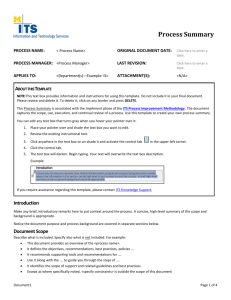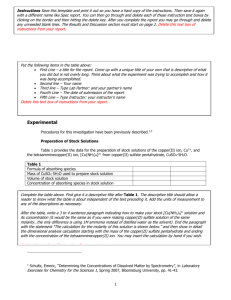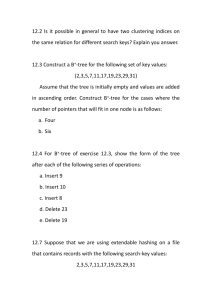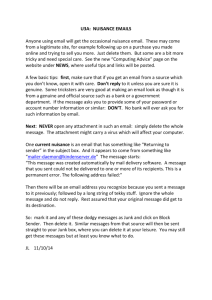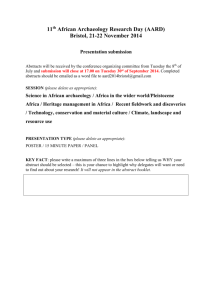for Problem Analysis Phase
advertisement
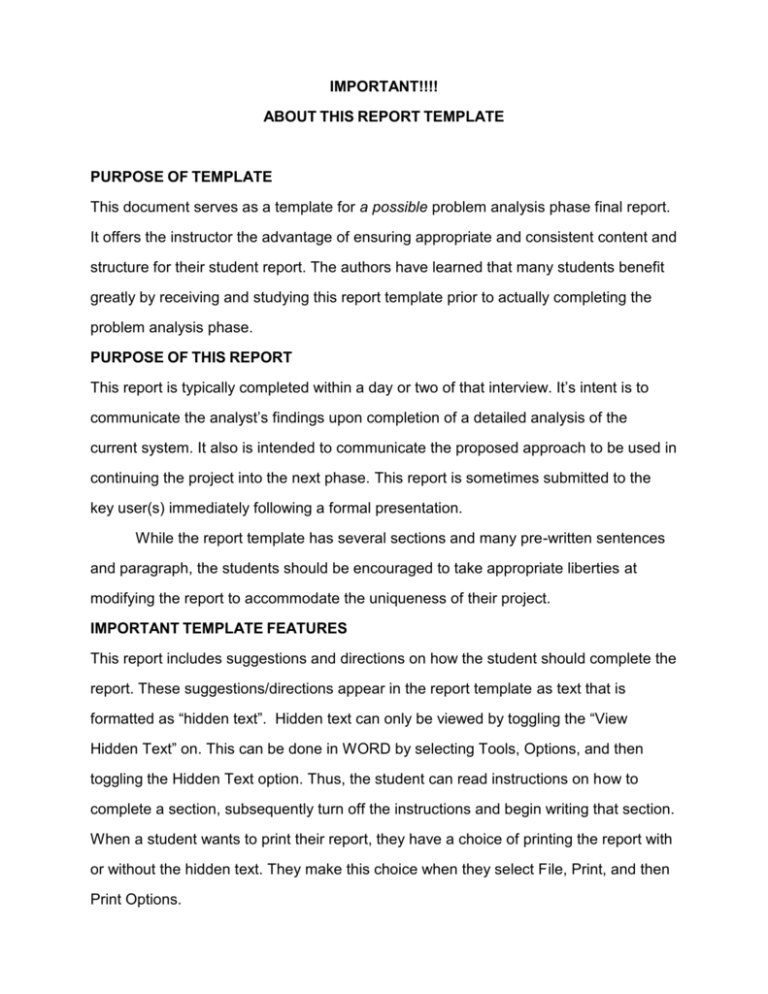
IMPORTANT!!!! ABOUT THIS REPORT TEMPLATE PURPOSE OF TEMPLATE This document serves as a template for a possible problem analysis phase final report. It offers the instructor the advantage of ensuring appropriate and consistent content and structure for their student report. The authors have learned that many students benefit greatly by receiving and studying this report template prior to actually completing the problem analysis phase. PURPOSE OF THIS REPORT This report is typically completed within a day or two of that interview. It’s intent is to communicate the analyst’s findings upon completion of a detailed analysis of the current system. It also is intended to communicate the proposed approach to be used in continuing the project into the next phase. This report is sometimes submitted to the key user(s) immediately following a formal presentation. While the report template has several sections and many pre-written sentences and paragraph, the students should be encouraged to take appropriate liberties at modifying the report to accommodate the uniqueness of their project. IMPORTANT TEMPLATE FEATURES This report includes suggestions and directions on how the student should complete the report. These suggestions/directions appear in the report template as text that is formatted as “hidden text”. Hidden text can only be viewed by toggling the “View Hidden Text” on. This can be done in WORD by selecting Tools, Options, and then toggling the Hidden Text option. Thus, the student can read instructions on how to complete a section, subsequently turn off the instructions and begin writing that section. When a student wants to print their report, they have a choice of printing the report with or without the hidden text. They make this choice when they select File, Print, and then Print Options. This template has been formatted for double spacing. Instructors may want student reports submitted in double-space format to allow more space for making grading comments. However, it is highly recommended that any final printed report that is to be given to the user first be formatted for single spacing. Students must be take responsibility to proof spelling, page breaks, page numbering, formatting and alignment, and other report quality issues. Finally, students should understand that this report is to be written TO THE USER(S)….not about the users, nor is it written to the Instructor. Thus, check to ensure that the report is written to the correct audience. Also, be sure that the report reflects whether you are working alone or as an individual (i.e. change “I” to “We” or vice versa). GOOD LUCK! ANALYSIS OF THE CURRENT <Insert the name of your system> by <insert Your name and Team Member Names> ANALYSIS OF THE CURRENT <insert the name of your system> Purpose This report presents the detailed findings of our team's investigation of your current <insert name> system. We also update our ideas for solutions (to be further investigated in the next phase). Finally, this report outlines our proposal of the procedures and schedule to be followed for the next two phases of the project. If you find any discrepancies or misconceptions, please bring them to our immediate attention. We will schedule a meeting to discuss the contents of this report. History Scope Report Contents and Organization This report initially describes the methods and procedures used to conduct a study and analysis of your current system. The next section summarizes the operation of the current system. This is followed by a detailed analysis of the current system. We have identified and analyzed the current system for problems, opportunities, and constraints. The next section presents an update of possible solutions to be investigated in the next two phases. phases. This section also presents the tasks and schedule for the next two Under separate cover sheets and for your convenience, we have included a summary version of this report. It is titled Summary Analysis Of The Current <Insert the name of your system>. This report may be convenient for presenting our findings to alternative audiences. PROCEDURES AND METHODS USED DURING THIS INVESTIGATION This section was designed to give you a brief summary of the methods and procedures used in our investigation. You should notify us of any potential omissions or mistakes that may render our findings incomplete or inaccurate. Procedures Initially, we conducted a preliminary investigation of your system. The preliminary investigation consisted of an interview of our key contact, <insert name>. Our preliminary findings were documented in an earlier report entitled Feasibility Survey And Project Overview <complete or replace title>, dated <insert date submitted>. The following is a list of methods and procedures followed in the subsequent detailed investigation of your system: 1. The following forms and reports were sampled: a. 2. <insert list> The following existing documentation was studied: b. <insert list> 3. #. This problem analysis phase report was written. Methods This report contains high-level pictures that diagram the flow of documents and data through your system. In the interest of brevity, this report only contains high-level pictures of the current system. The pictures use the following special symbols: A square represents a person, department, organization, or system that is beyond the scope of the system that we studied, but which provides input to or receives outputs from the system being studied. In other words, the squares define where the system begins and ends. A rounded rectangle represents performed in, by, or for the system. work that is This includes work performed by people and machines. An open-ended box represents data storage, either temporary or permanent. This includes in/out boxes, log sheets, reference books, manual files, and computer files. An arrow represents the actual flow of documents, messages (possibly verbal), and reports through the system. Each arrow can be thought of as a pipeline through which one or more occurrences of the named flow travel. OVERVIEW OF CURRENT SYSTEM OPERATIONS In this section of the report, we present our understanding of your current system operations. System Participants and Interested Parties To date, we have identified the following list of participants for this system. Please inform us of any potential omissions. > 1. Management - Direct Users a. <name>, <title> b. <name>, <title> > 2. Other Direct Users a. <name>, <title> b. <name>, <title> > 3. People or Departments Affected by or Interested in the System (but not necessarily a direct user of the system) a. <name>, <title> b. <name>, <title> System Environment The system we studied can be conveniently broken down into the following subsystems: These systems are organized as illustrated in Figure <insert #>. System Interfaces Context. System Data Context. ANALYSIS OF THE CURRENT SYSTEM This is the most important section of this report. It analyzes the current system, describing and analyzing problems, opportunities, and constraints. Problems, opportunities, and constraints include those identified by you and those perceived by our own team. Keep in mind, we are analyzing "the system," not the people in the system. A problem is a situation that results in an undesirable side effect. All problems will be defined in the following way: problem statement cause(s), and net effect(s). Sometimes confused for solutions to problems, opportunities are actually situations that we have identified as possible areas for improvement, despite not being specific problems. Computer automation is not an opportunity (only a way to exploit an opportunity). Opportunities are stated as follows: statement and business benefit that can be derived by exploiting the opportunity. A constraint is an existing or anticipated situation that may constrain any improved system that we may recommend in the subsequent phases of this project. In other words, a constraint is something which cannot or should not be changed (e.g. policies, regulations, equipment, deadlines, budget, etc.). All constraints are stated along with the rationale for not being able to change the constraint. Problems, opportunities, and constraints are presented within a framework called PIECES (developed by James Wetherbe and refined by Whitten/Bentley). The letters in the acronym classify the problems, opportunities, and constraints: P erformance I nformation and data E conomy (costs) C ontrol and security E fficiency S ervice and overall usefulness A single problem, opportunity, or constraint may show up in more than one category; however, there would be different implications. For example, a single problem may have performance, economic, control, efficiency, et al, implications. A miscellaneous category is added to cover items which can't be categorized by PIECES analytical framework. Each category will be further defined in the subsequent subsections. Later in this project, PIECES will be used to analyze system solutions. Performance Analysis Performance analysis generally applied to the systems transactions (or inputs). When discussing the performance of any given transaction, we need to discuss both throughput and response time. Throughput is the number of transactions processed in some specified period of time (e.g. 50 per day). Response time is the time required to process a single transaction. This section analyzes the transactions for performance problems and opportunities. Transaction: <name> Throughput: <average quantity per time period, average quantity during peak period, and average quantity during low (or valley) period - be sure to designate when peak and valley periods occur> Response Time: <average time required to process a single transaction during normal workload period, average time to process during peak workload period, and average time to process during low (or valley) workload period - be sure to designate when peak and valley periods occur> Anticipated Growth: <percent growth per time period> Problem: <is throughput or response time bad or unacceptable?> Cause: <delete if no problem> Effect: <delete if no problem> Opportunity: <is throughput or response time acceptable, but could be improved?> Benefit: Constraint: <delete if no opportunity> <is there an existing or anticipated situation that may constrain any improved system that we may recommend? if so, state rationale for not being able to change the constraint. delete if not applicable> Possible Improvements: <describe possible solutions to problems or ways to fulfill opportunity> Information and Data Analysis Information analysis examines the outputs of a system. Outputs include reports and inquiry responses. Data analysis examines the data stored within a system. Information Analysis. Information analysis initially identifies those net outputs produced by or for the system. Each output is analyzed for the following possible problems or opportunities: Information overload. Either too many outputs are produced or outputs contain too much information, limiting their usefulness. Information accuracy. Information contains errors or possible errors. Information timeliness. Information is not received fast enough to be useful. Information format. Information is in a format that is either not useful or must be modified to become useful. Information redundancy. Multiple outputs contain much of the same information. Lack of information. Information is not available to aid in decision making. The outputs are listed and identified as follows. Output: <name> Format: <current format> Frequency: <how often produced> Problem: <is the output unacceptable relative to one or more of the above problem categories?> Cause: <delete if no problem> Effect: <delete if no problem> Opportunity: <do the users view the report acceptable according to the above problem categories, yet it could be improved?> Benefit: Constraint: <delete if no opportunity> <is there an existing or anticipated situation that may constrain any improved system that we may recommend? if so, state rationale for not being able to change the constraint. delete if not applicable> Possible Improvements: <describe possible solutions to problems or ways to fulfill opportunity> Data Analysis. Data analysis describes the degree to which data is redundantly stored within the system, the ease (or lack thereof) of access to data (e.g. how easy or difficult it is to produce information and outputs from the data), and the accuracy and consistency of stored data. The stored data are listed and identified as follows. Data Stored: <name> Number of records: <average> Anticipated growth: <percentage growth per time period - typically estimate over 5 year period> Medium: <physical storage medium> Organization: <how are records organized?> Problem: <is the data unacceptable relative to one or more of the above problem categories?> Cause: <delete if no problem> Effect: <delete if no problem> Opportunity: <is the stored data acceptable according to the above problem categories, yet could be improved?> Benefit: Constraint: <delete if no opportunity> <is there an existing or anticipated situation that may constrain any improved system that we may recommend? if so, state rationale for not being able to change the constraint. delete if not applicable> Possible Improvements: <describe possible solutions to problems or ways to fulfill opportunity> Economic Analysis Economic analysis examines the system for cost problems (e.g. excessive costs or insufficient cost controls) or cost reduction opportunities. It can also be used to present budget constraints. Problem: <is the cost excessive and unacceptable or are costs unknown or untraceable to source?> Cause: <delete if no problem> Effect: <delete if no problem> Opportunity: <is the cost and cost monitoring acceptable but could be improved?> Benefit: Constraint: <delete if no opportunity> <is there an existing or anticipated situation that may constrain any improved system that we may recommend? if so, state rationale for not being able to change the constraint. delete if not applicable> Possible Improvements: <describe possible solutions to problems or ways to fulfill opportunity> Control and Security Analysis Controls analysis examines how the system ensures that it is properly operating. Security analysis is concerned with both facility and data security. The system was examined both for excessive controls and lack of controls. Controls are measures taken to eliminate mistakes and tampering. implications. Controls can also have performance Problem: <are the controls and security excessive or lacking?> Cause: <delete if no problem> Effect: <delete if no problem> Opportunity: Benefit: Constraint: <could controls and security be improved?> <delete if no opportunity> <is there an existing or anticipated situation that may constrain any improved system that we may recommend? if so, state rationale for not being able to change the constraint. delete if not applicable> Possible Improvements: <describe possible solutions to problems or ways to fulfill opportunity> Efficiency Analysis Efficiency analysis is sometimes confused with economic analysis. Efficiency analysis examines the system for problems and opportunities related to how resources (e.g. people, facilities, money, etc.) are being used. Efficiency problems and opportunities usually target resources that could be better used (not eliminated). > > Problem: <are resources being efficiently utilized? if not, is it unacceptable?> Cause: <delete if no problem> Effect: <delete if no problem> Opportunity: <although the resource utilization efficiency is acceptable, can it be improved?> Benefit: Constraint: <delete if no opportunity> <is there an existing or anticipated situation that may constrain any improved system that we may recommend? if so, state rationale for not being able to change the constraint. delete if not applicable> Possible Improvements: <describe possible solutions to problems or ways to fulfill opportunity> Service Analysis Service analysis takes on several forms. The following list is not exhaustive: Processing and data accuracy (manual and computer). Especially for computerized systems, is data being properly edited prior to file updates? Reliability of the system. Are transactions and situations handled consistently? Recoverability of the system. Especially for computerized systems, is data being periodically backed up? Maintainability of the system. Especially for computerized systems, has the system been properly maintained? Can it be maintained? How good is the documentation? Ease of use. For both computerized and manual systems or subsystems, is the system easy to learn and use? Flexibility. Are the situations or conditions that the system cannot handle? Coordination. Do the people in the system appear to coordinate their activities? Do actions or decisions ever contradict? Do people understand how their fellow workers interface to their jobs? Customer and/or employee goodwill or morale. > Problem: <is one or more of the above problem categories unacceptable?> Cause: <delete if no problem> Effect: <delete if no problem> Opportunity: <while currently acceptable, could it (see problem categories listed above) be improved?> Benefit: <delete if no opportunity> Constraint: <is there an existing or anticipated situation that may constrain any improved system that we may recommend? if so, state rationale for not being able to change the constraint. delete if not applicable> Possible Improvements: <describe possible solutions to problems or ways to fulfill opportunity> Miscellaneous Analysis RECOMMENDATIONS In this section of the report we make recommendations regarding the status of the project and revise our schedule. Recommendations and Proposal We propose to define user business requirements for an improved system. This section of the report outlines our proposal. The next phase of our project is commonly referred to as the definition phase. The definition phase activities involve: 1. Soliciting facts about business requirements. 2. Defining and documenting the data storage for a new system. 3. Defining and documenting essential inputs needed for an improved system. 4. Defining and documenting essential outputs needed for an improved system. 5. Defining and documenting the business processes for an improved system. 6. Defining and documenting the geographic support requirements for an improved system. 7. Packaging a comprehensive business requirements statement that will guide future project phases. 8. Schedule for Completion of Definition Phase The estimated schedule for completing these definition phase activities is depicted in figure <insert figure #>. CONCLUSION This report has presented the findings of a detailed investigation of your existing <insert name> system. Please review this report at your earliest convenience. We anxiously await your reaction to our findings. We thank you for your cooperation in compiling this analysis and we look forward to working with you as we begin to plan and design possible improvements to your system. Appendix A <title>


